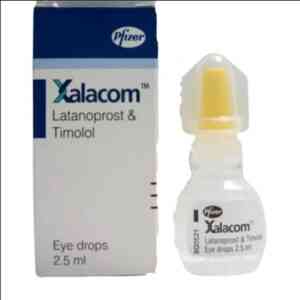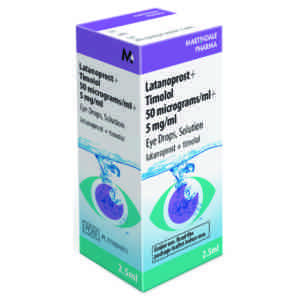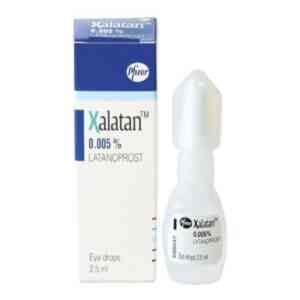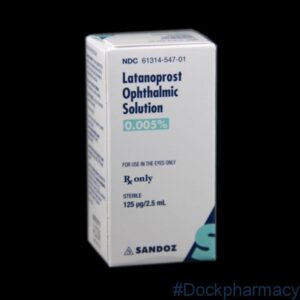- Preservative Free latanoprost eye drops
- Single Unit Dose
- Description
- Additional Information
- Brand
- How To Use
- Product Details
- Side Effects
- Ingredients
- Patient Information leaflet
- Reviews (1)
- Questions & Answers (4)
Monopost Eye Drops – Latanoprost Preservative Free, 30 Single Dose Units
Looking for a preservative free Latanoprost eye drop to help treat your open angle glaucoma or ocular hypertension? Look no further than Monopost Eye Drops Preservative Free. Formulated with latanoprost, Monopost is an effective way to help lower the pressure within your eye, thus lessening the risk of vision problems down the road. And because it’s preservative-free, it’s ideal for those with sensitive eyes. So why wait? Get started on treatment today with Monopost Eye Drops Preservative Free.
Monopost Eye Drops, latanoprost Preservative Free is used to treat conditions known as open angle glaucoma and ocular hypertension in adults.
Both of these conditions are linked with an increase in the pressure within your eye, eventually affecting your eye sight.
Latanoprost preservative Free eye drops is also used to treat increased eye pressure and glaucoma in all ages of children and babies and also Latanoprost eye drops can be used in dogs and cats.
Monopost eye drops is preservative free active ingredient latanoprost
Patients should be instructed:
– to avoid contact between the dropper tip and the eye or eyelids,
– to use the eye drops solution immediately after first opening the single-dose container and to discard the single-dose after use.
What is Glaucoma?
Glaucoma is a common eye condition where the optic nerve, which connects the eye to the brain, becomes damaged.
It’s usually caused by fluid building up in the front part of the eye, which increases pressure inside the eye.
Glaucoma can lead to loss of vision if it’s not diagnosed and treated early.
It can affect people of all ages, but is most common in adults in their 70s and 80s.
Glaucoma does not usually cause any symptoms to begin with.
It tends to develop slowly over many years and affects the edges of your vision (peripheral vision) first.
For this reason, many people do not realise they have glaucoma, and it’s often only picked up during a routine eye test.
If you do notice any symptoms, they might include blurred vision, or seeing rainbow-coloured circles around bright lights.
Both eyes are usually affected, although it may be worse in 1 eye.
Very occasionally, glaucoma can develop suddenly and cause:
Visit an opticians or a GP if you have any concerns about your vision.
If you have glaucoma, early diagnosis and treatment can help stop your vision getting worse.
Without treatment, glaucoma can eventually lead to blindness.
If you develop symptoms of glaucoma suddenly, go to your nearest eye casualty unit or A&E as soon as possible.
This is a medical emergency that may require immediate treatment.
There are several different types of glaucoma.
The most common is called primary open angle glaucoma. This tends to develop slowly over many years.
It’s caused by the drainage channels in the eye becoming gradually clogged over time.
Other types of glaucoma include:
- acute angle closure glaucoma – an uncommon type caused by the drainage in the eye becoming suddenly blocked, which can raise the pressure inside the eye very quickly
- secondary glaucoma – caused by an underlying eye condition, such as inflammation of the eye (uveitis)
- childhood glaucoma (congenital glaucoma) – a rare type that occurs in very young children, caused by an abnormality of the eye
Glaucoma can occur for a number of reasons.
Most cases are caused by a build-up of pressure in the eye when fluid is unable to drain properly.
This increase in pressure then damages the nerve that connects the eye to the brain (optic nerve).
It’s often unclear why this happens, although certain things can increase the risk, including:
- your age – glaucoma becomes more common as you get older
- your ethnicity – people of African, Caribbean or Asian origin are at a higher risk
- your family history – you’re more likely to develop glaucoma if you have a parent or sibling with the condition
- other medical conditions – such as short-sightedness, long-sightedness and diabetes
It’s not clear whether you can do anything to prevent glaucoma, but having regular eye tests should pick it up as early as possible.
TESTS FOR GLAUCOMA
Glaucoma can usually be detected during a routine eye test at an opticians, often before it causes any noticeable symptoms.
The tests are carried out in the opticians by an optometrist.
You should have a routine eye test at least every 2 years.
Find out if you’re eligible for free NHS eye tests
Several quick and painless tests can be carried out to check for glaucoma, including vision tests and measurements of the pressure inside your eye.
If tests suggest you have glaucoma, you should be referred to a specialist eye doctor (ophthalmologist) to discuss treatment.
It’s not possible to reverse any loss of vision that occurred before glaucoma was diagnosed, but treatment can help stop your vision getting worse.
The treatment recommended for you will depend on the type of glaucoma you have, but the options are:
- eyedrops – to reduce the pressure in your eyes
- laser treatment – to open up the blocked drainage tubes or reduce the production of fluid in your eyes
- surgery – to improve the drainage of fluid
You’ll also probably need regular appointments to monitor your condition and check the treatment is working.
Monopost Eye Drops Reviews
After using Monopost Eye Drops, it’s helpful to let others know about your experience. Reviews of an item help other users know that medicines received have helped the condition it is claimed for, how well the treatment worked or any issues to be aware of. We invite our users to leave a review of both their treatment and of the service provided. Click on the reviews tab to see if there has been feedback on this item.
What is the price of Monopost Eye Drops?
The price of Monopost Eye Drops is £13.45
Where can you buy Monopost Eye Drops?
You can buy Monopost Eye Drops at Dock Pharmacy Essex UK, UK Online Pharmacy.
Can you buy Monopost Eye Drops Over the counter?
Monopost Eye Drops is not available to buy over the counter. You need a prescription to buy Monopost Eye Drops
| Brand | |
|---|---|
Brand
monopost
How To Use
Recommended dosage for adults (including the elderly):
Recommended therapy is one eye drop in the affected eye(s) once daily. Optimal effect is obtained if MONOPOST is administered in the evening.
The dosage of MONOPOST should not exceed once daily since it has been shown that more frequent administration decreases the intraocular pressure lowering effect.
If one dose is missed, treatment should continue with the next dose as normal.
Product Details
Latanoprost may gradually change eye colour by increasing the amount of brown pigment in the iris. Before treatment is instituted, patients should be informed of the possibility of a permanent change in eye colour. Unilateral treatment can result in permanent heterochromia.
This change in eye colour has predominantly been seen in patients with mixed coloured irides, i.e. blue-brown, grey-brown, yellow-brown and green-brown. In studies with latanoprost, the onset of the change is usually within the first 8 months of treatment, rarely during the second or third year, and has not been seen after the fourth year of treatment. The rate of progression of iris pigmentation decreases with time and is stable for five years. The effect of increased pigmentation beyond five years has not been evaluated. In an open 5-year latanoprost safety study, 33% of patients developed iris pigmentation (see section 4.8). The iris colour change is slight in the majority of cases and often not observed clinically. The incidence in patients with mixed colour irides ranged from 7 to 85%, with yellow-brown irides having the highest incidence. In patients with homogeneously blue eyes, no change has been observed and in patients with homogeneously grey, green or brown eyes, the change has only rarely been seen.
The colour change is due to increased melanin content in the stromal melanocytes of the iris and not to an increase in number of melanocytes. Typically, the brown pigmentation around the pupil spreads concentrically towards the periphery in affected eyes, but the entire iris or parts of it may become more brownish. No further increase in brown iris pigment has been observed after discontinuation of treatment. It has not been associated with any symptom or pathological changes in clinical trials to date.
Neither naevi nor freckles of the iris have been affected by treatment. Accumulation of pigment in the trabecular meshwork or elsewhere in the anterior chamber has not been observed in clinical trials. Based on 5 years clinical experience, increased iris pigmentation has not been shown to have any negative clinical sequelae and latanoprost can be continued if iris pigmentation ensues. However, patients should be monitored regularly and if the clinical situation warrants, latanoprost treatment may be discontinued.
There is limited experience of latanoprost in chronic angle closure glaucoma, open angle glaucoma of pseudophakic patients and in pigmentary glaucoma. There is no experience of latanoprost in inflammatory and neovascular glaucoma, inflammatory ocular conditions, or congenital glaucoma. Latanoprost has no or little effect on the pupil, but there is no experience in acute attacks of closed angle glaucoma. Therefore, it is recommended that latanoprost should be used with caution in these conditions until more experience is obtained.
There are limited study data on the use of latanoprost during the peri-operative period of cataract surgery. Latanoprost should be used with caution in these patients.
Latanoprost should be used with caution in patients with a history of herpetic keratitis, and should be avoided in cases of active herpes simplex keratitis and in patients with history of recurrent herpetic keratitis specifically associated with prostaglandin analogues.
Reports of macular oedema have occurred (see section 4.8) mainly in aphakic patients, in pseudophakic patients with torn posterior lens capsule or anterior chamber lenses, or in patients with known risk factors for cystoid macular oedema (such as diabetic retinopathy and retinal vein occlusion). Latanoprost should be used with caution in aphakic patients, in pseudophakic patients with torn posterior lens capsule or anterior chamber lenses, or in patients with known risk factors for cystoid macular oedema.
In patients with known predisposing risk factors for iritis/uveitis, latanoprost can be used with caution.
Ingredients
The active substance is latanoprost 1 ml of solution contains 50 micrograms latanoprost
Patient Information leaflet
Click here for the Patient Information leaflet
Please read before using the product
1 review for Monopost Eye Drops – Latanoprost Preservative Free, 30 Single Dose Units
Only logged in customers who have purchased this product may leave a review.
Questions and answers of the customers
- There are no answers for this question yet.
- There are no answers for this question yet.
- There are no answers for this question yet.
- There are no answers for this question yet.
You Might Also Like
Original price was: £20.05.£18.50Current price is: £18.50.
- Treatment of Glaucoma
- Active Ingredients: latanoprost and timolol.
- Prescription Product
- Vet Prescription Accepted
Original price was: £20.05.£18.50Current price is: £18.50.
- Availability: in stock
- Active ingredients: latanoprost and timolol.
- Treatment of Glaucoma
- Alternate name: Xalacom
£11.50
- Availability: in stock
Original price was: £19.40.£17.50Current price is: £17.50.
- Open angle glaucoma and ocular hypertension treatment
- Xalatan can be used for Dogs and cats ( under Vet)
- Active Ingredient: Latanoprost
Original price was: £19.40.£17.50Current price is: £17.50.
- Availability: in stock
Original price was: £14.50.£7.90Current price is: £7.90.
- You can buy Latanoprost eye drops for dogs and cats online with a Vet valid prescription.
- Treatment for Glaucoma
Learn More
Original price was: £14.50.£7.90Current price is: £7.90.
- Availability: in stock
Other Products From This Seller
Original price was: £31.00.£10.95Current price is: £10.95.
Chopard Wish Eau de Parfum 30ml Sweet and Oriental Fragrance for Women Indulge in elegance with Chopard Wish Eau de Parfum, 30ml, a sweet and oriental fragrance for women that exudes sophistication and charm. This luxurious scent by Chopard is inspired by the allure of wishes and dreams, blending warm and sensual notes for a […]
Learn MoreOriginal price was: £31.00.£10.95Current price is: £10.95.
- Availability: in stock
Original price was: £84.00.£26.95Current price is: £26.95.
Vera Wang Lovestruck Eau de Parfum 100ml Romantic Floral and Feminine Fragrance Celebrate romance and femininity with Vera Wang Lovestruck Eau de Parfum, 100ml, a romantic floral fragrance for women inspired by love at first sight. This enchanting scent captures the essence of passion and charm with a blend of delicate florals and sweet fruity […]
Learn MoreOriginal price was: £84.00.£26.95Current price is: £26.95.
- Availability: in stock
Original price was: £25.00.£9.95Current price is: £9.95.
Gloria Vanderbilt Vanderbilt EDT Spray, 100ml Timeless Floral Elegance Embrace timeless elegance with Gloria Vanderbilt Vanderbilt Eau De Toilette Spray, 100ml, a sophisticated floral fragrance for women that captures grace, femininity, and charm. Designed for confident and classic women, this iconic scent by Gloria Vanderbilt combines delicate floral notes with warm undertones for a long-lasting […]
Learn MoreOriginal price was: £25.00.£9.95Current price is: £9.95.
- Availability: in stock
Original price was: £34.00.£15.95Current price is: £15.95.
Elizabeth Arden Splendor Eau De Parfum, 125 ml Sophisticated Floral Fragrance Indulge in timeless elegance with Elizabeth Arden Splendor Eau De Parfum, 125ml, a sophisticated floral fragrance for women that exudes grace and charm. Inspired by moments of pure splendor, this iconic scent by Elizabeth Arden combines floral and woody notes for a captivating and […]
Learn MoreOriginal price was: £34.00.£15.95Current price is: £15.95.
- Availability: in stock
Original price was: £44.00.£19.95Current price is: £19.95.
Elizabeth Arden Red Door Eau De Toilette Spray 50ml Timeless Floral Elegance Step into timeless elegance with Elizabeth Arden Red Door Eau De Toilette Spray, 50ml, a classic floral fragrance for women that has become an icon of sophistication. Inspired by the legendary Red Door Spa, this luxurious scent captures the essence of femininity with […]
Learn MoreOriginal price was: £44.00.£19.95Current price is: £19.95.
- Availability: in stock
Original price was: £55.00.£19.95Current price is: £19.95.
Estee Lauder Pleasures EDP 30ml Fresh and Floral Fragrance for Women Experience the timeless elegance of Estee Lauder Pleasures Eau de Parfum, 30ml, a fresh and floral fragrance for women that captures the beauty of life’s simplest pleasures. This classic scent by Estee Lauder is designed for modern, sophisticated women who appreciate light, airy fragrances. […]
Learn MoreOriginal price was: £55.00.£19.95Current price is: £19.95.
- Availability: in stock
Original price was: £34.99.£19.95Current price is: £19.95.
Sarah Jessica Parker Lovely You Eau de Parfum Spray 100ml Sophisticated Floral and Musky Fragrance Step into timeless elegance with Sarah Jessica Parker Lovely You Eau de Parfum Spray, 100ml, a floral and musky fragrance for women that embodies sophistication and modernity. Created by Sarah Jessica Parker, this iconic scent celebrates femininity with a delicate […]
Learn MoreOriginal price was: £34.99.£19.95Current price is: £19.95.
- Availability: in stock
Original price was: £47.00.£29.95Current price is: £29.95.
Kenzo Flower Eau De Toilette Spray 30ml Fresh and Floral Fragrance for Women Experience the delicate beauty of nature with Kenzo Flower Eau De Toilette Spray, 30ml, a fresh and floral fragrance for women inspired by the elegance of the red poppy. This iconic scent combines floral and powdery notes to create a delicate and […]
Learn MoreOriginal price was: £47.00.£29.95Current price is: £29.95.
- Availability: in stock
Original price was: £47.00.£29.95Current price is: £29.95.
Jimmy Choo Eau de Parfum 40ml Sweet and Floral Fragrance for Women Step into a world of luxury and confidence with Jimmy Choo Eau de Parfum, 40ml, a sweet and floral fragrance for women that embodies modern glamour. Designed for women who exude confidence and style, this Jimmy Choo perfume for women blends fruity and […]
Learn MoreOriginal price was: £47.00.£29.95Current price is: £29.95.
- Availability: in stock
Original price was: £52.00.£23.95Current price is: £23.95.
Issey Miyake L’Eau d’Issey Pure Nectar Eau de Parfum Spray, 30ml Floral and Aquatic Elegance Discover the purity of nature with Issey Miyake L’Eau d’Issey Pure Nectar Eau de Parfum Spray, 30ml, a floral and aquatic fragrance for women that encapsulates elegance and sophistication. This Issey Miyake perfume for women combines fresh and delicate notes […]
Learn MoreOriginal price was: £52.00.£23.95Current price is: £23.95.
- Availability: in stock



















Julie Brennan (verified owner) –
Jumoke Odebiyi –
Dear Julie, thank you for your 5-star review.